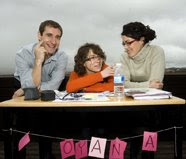 The conference was divided into two parts. The first part consisted of talks by 4 speakers who were introducing various subjects/views/ideas/policies. The second half was run using Open Space Technology (see blow) that was allowing people to share their views and discuss burning from individuals' point of view issues related to the subject of the conference. So it wasn't feeding delegates with the only truth about measuring not measurable. It was a platform to start dialogue about existing ways of measuring creativity and start conversation about other ways.
The conference was divided into two parts. The first part consisted of talks by 4 speakers who were introducing various subjects/views/ideas/policies. The second half was run using Open Space Technology (see blow) that was allowing people to share their views and discuss burning from individuals' point of view issues related to the subject of the conference. So it wasn't feeding delegates with the only truth about measuring not measurable. It was a platform to start dialogue about existing ways of measuring creativity and start conversation about other ways.Open Space Technology and actually introduction to this working method is one of the most interesting things i have learnt during the day!
The final outcomes due to the nature of the working methods are not available on the day. When any gathered information arrives to me I will post it on the blog.
Quick intro to OST:
Open Space Technology (OST)enables groups of any size to address complex, important issues and achieve meaningful results quickly. It functions best where more traditional meeting formats fail: when there is conflict, complexity, diversity of thought or people, and short decision times. It has been used in widely diverse settings, from designing aircraft doors at a large aircraft manufacturing company to engaging street kids in defining a sustainable jobs program.
It is a new and powerful meeting methodology!
Four principles:
- Whoever comes are the right people
- Whatever happens is the only thing that could have
- Whenever it starts is the right time
- When it's over, it's over
The "Law of Two Feet" — a foot of passion and a foot of responsibility — expresses the core idea of taking responsibility for what one loves. In practical terms, the law says that if you're neither contributing nor getting value where you are, use your two feet (or available form of mobility) and go somewhere where you can.
People can choose different roles for participation in Open Space meetings:
- Host: the person who feels a burning passion for the subject and is willing to take responsibility to call the conversation, invite others in and make sure something gets harvested.
- Participant: Anyone who is drawn to a conversation wants to stay the whole time and participate fully.
- Bumble bee: The ones who move from conversation to conversation cross-pollinating the learning.
- Butterfly: A butterfly may not want to be in any conversation, instead they prefer to sit on the lawn and look beautiful. A new, unexpected conversation may happen when two butterflies meet.



No hay comentarios:
Publicar un comentario